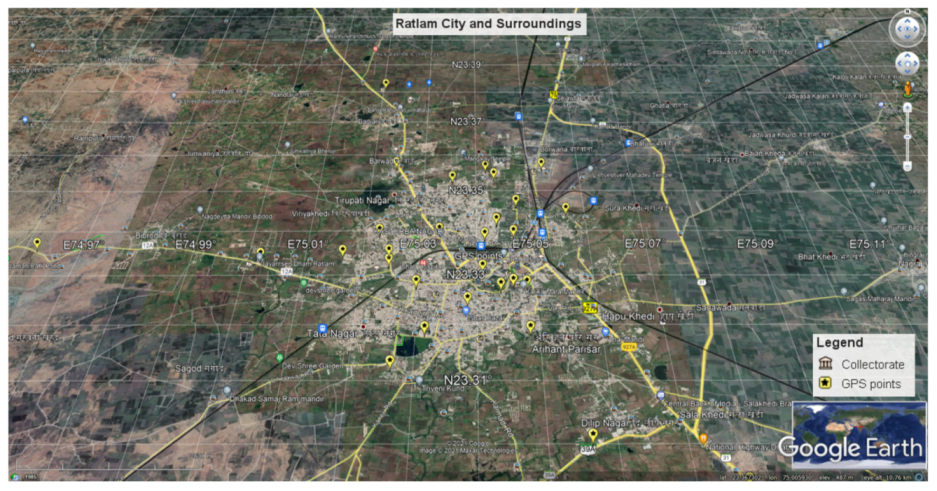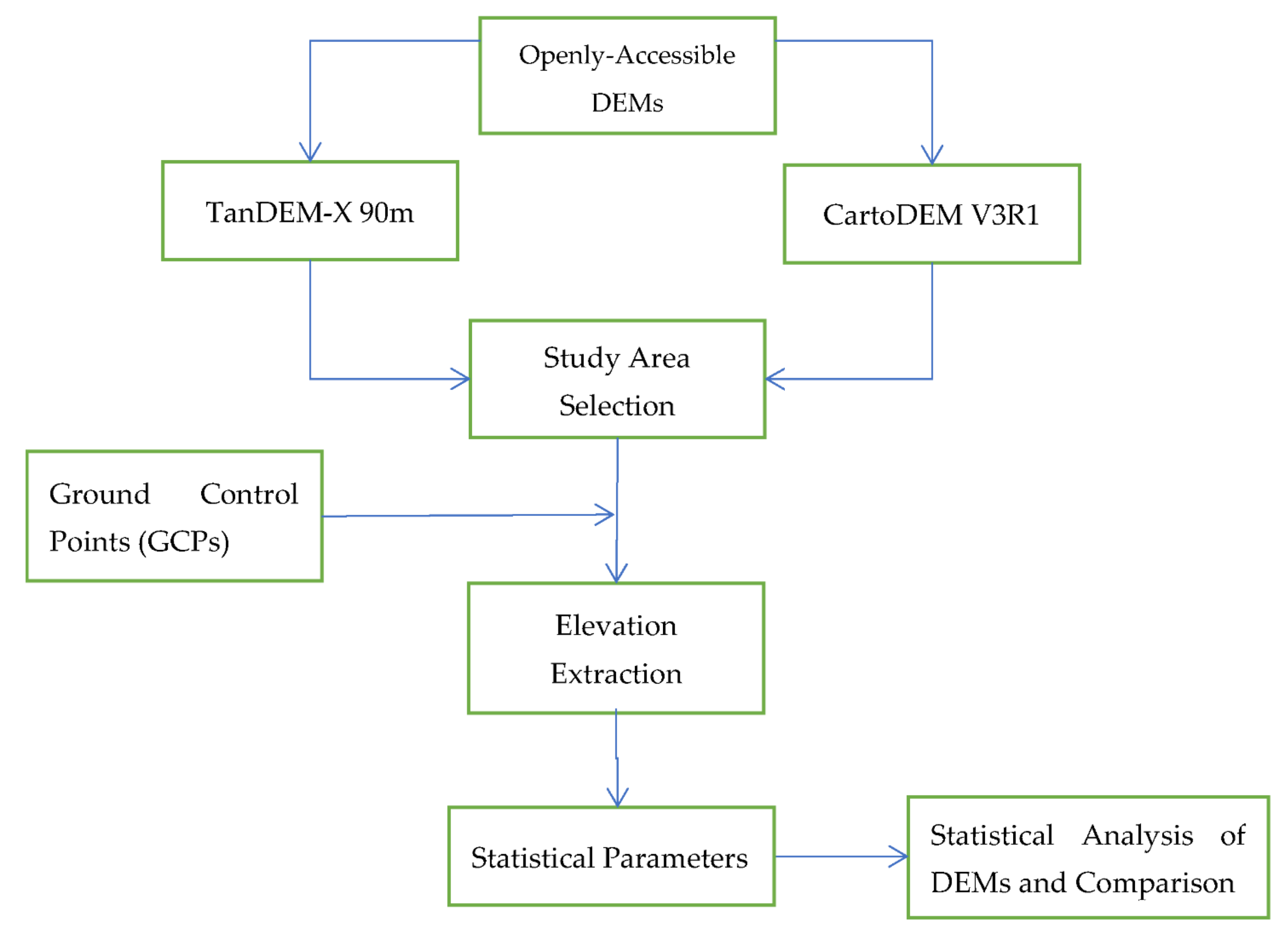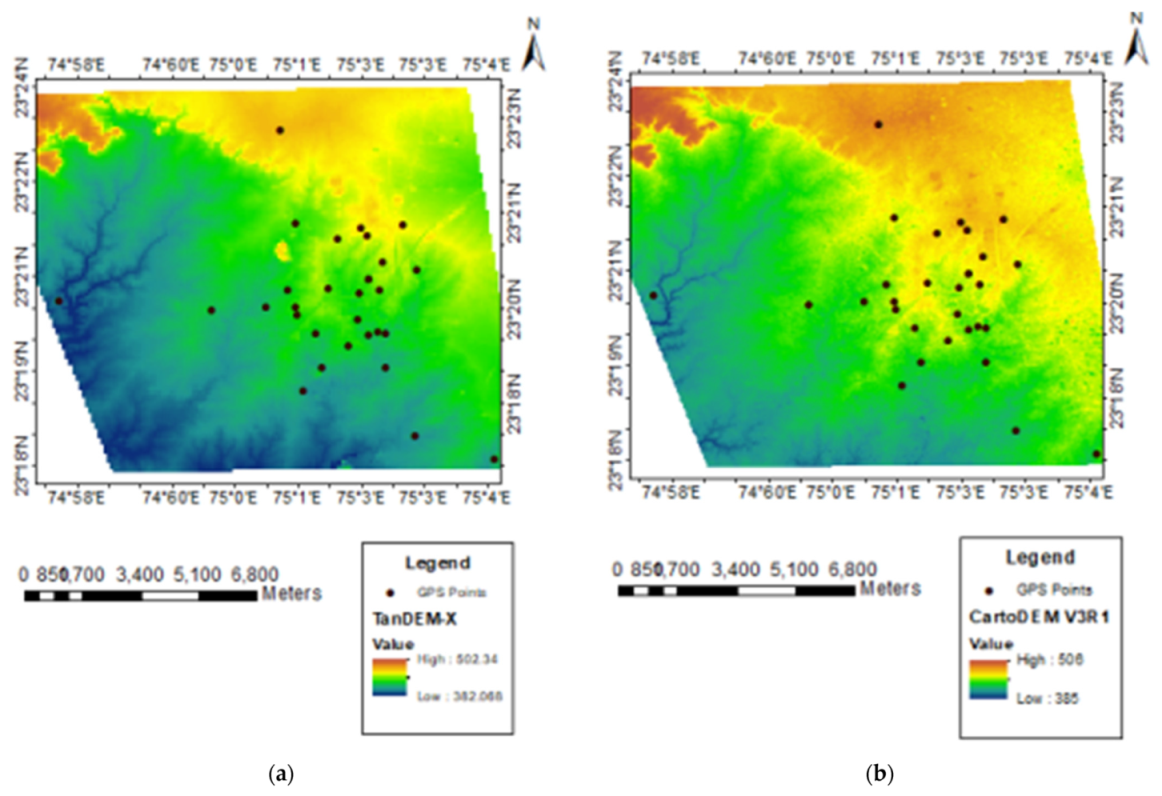Accuracy Assessment of Openly Accessible CartoDEM V3 R1 and TanDEM-X 90 Using a Smartphone with Assisted GPS for Ratlam City and Surroundings †
Abstract
1. Introduction
2. Material and Method
2.1. Study Area
2.2. Ground Control Point (GCP) Collection
2.3. Statistical Analysis
3. Results and Discussion
4. Conclusions
Author Contributions
Funding
Institutional Review Board Statement
Informed Consent Statement
Data Availability Statement
Acknowledgments
Conflicts of Interest
References
- Durmaz, A.I. Creating digital elevation model using a mobile device. ISPRS Ann. Photogramm. Remote Sens. Spat. Inf. Sci. 2017, 4, 203–207. [Google Scholar] [CrossRef]
- Venkateswarlu, E.; Raghuramulu, I.; Sivannarayana, T.; Swamy, G.P.; Krishna, B.G. Quality Evaluation of CartoDEM in Different Resolutions. In Proceedings of International Conference on Remote Sensing for Disaster Management; Springer: Berlin/Heidelberg, Germany, 2018; pp. 73–81. [Google Scholar] [CrossRef]
- Srivastava, P.K.; Srinivasan, T.P.; Gupta, A.; Singh, S.; Nain, J.S.; Prakash, S.; Kartikeyan, B.; Krishna, B.G. Recent advances in Cartosat-1 data processing. In The International Archives of the photogrammetry, Remote Sensing and Spatial Information Science; ISPRS Hannover Workshop; 2007; Volume XXXVI/1-W5, p. 10. Available online: https://www.isprs.org/proceedings/xxxvi/1-w51/paper/Srivastava_etal.pdf (accessed on 30 July 2021).
- Patel, A.; Katiyar, S.K.; Prasad, V. Performances evaluation of different open source DEM using Differential Global Positioning System (DGPS). Egypt. J. Remote Sens. Space Sci. 2016, 19, 7–16. [Google Scholar] [CrossRef]
- Kumar, V.; Bhardwaj, A.; Haldar, A.L. Assessment of vertical accuracy of open source dems in parts of gangetic plain region with ICESat data. In Proceedings of the 38th Asian Conference on Remote Sensing—Space Applications: Touching Human Lives, ACRS 2017, New Delhi, India, 23–27 October 2017. [Google Scholar]
- Khalid, N.F.; Din, A.H.M.; Omar, K.M.; Khanan, M.F.A.; Omar, A.H.; Hamid, A.I.A.; Pa’Suya, M.F. Open-source digital elevation model (dems) evaluation with gps and lidar data. Int. Arch. Photogramm. Remote Sens. Spat. Inf. Sci. 2016, 42, 299–306. [Google Scholar] [CrossRef]
- Sefercik, U.G. Comparison of DEM Accuracies Generated by Various Methods. In Proceedings of the 2007 3rd International Conference on Recent Advances in Space Technologies, Istanbul, Turkey, 14–16 June 2007; IEEE: Piscataway, NJ, USA, 2007; pp. 379–382. [Google Scholar] [CrossRef]
- Bhardwaj, A.; Jain, K.; Chatterjee, R.S. Generation of high-quality digital elevation models by assimilation of remote sensing-based DEMs. J. Appl. Remote Sens. 2019, 13, 044502. [Google Scholar] [CrossRef]
- Liu, Z.; Zhu, J.; Fu, H.; Zhou, C.; Zuo, T. Evaluation of the Vertical Accuracy of Open Global DEMs over Steep Terrain Regions Using ICESat Data: A Case Study over Hunan Province, China. Sensors 2020, 20, 4865. [Google Scholar] [CrossRef] [PubMed]
- Raghunath, S.; Malleswari, B.; Sridhar, K. Analysis of Gps Errors During Different Times in a Day. Int. J. Res. Comput. Sci. 2011, 2, 45–48. [Google Scholar] [CrossRef][Green Version]
- Sunda, S.; Sridharan, R.; Vyas, B.M.; Khekale, P.V.; Parikh, K.S.; Ganeshan, A.S.; Sudhir, C.R.; Satish, S.V.; Bagiya, M.S. Satellite-based augmentation systems: A novel and cost-effective tool for ionospheric and space weather studies. Space Weather 2014, 13, 6–15. [Google Scholar] [CrossRef]
- Gianniou, M.; Mitropoulou, E. Impact of High Ionospheric Activity on GPS Surveying: Experiences from the Hellenic RTK-Network during 2011–2012. EUREF Annual Symposium. 2012. Available online: www.sidc.be(http://www.euref.eu/symposia/2012Paris/02-08-p-Gianniou.pdf (accessed on 30 July 2021).
- Merry, K.; Bettinger, P. Smartphone GPS accuracy study in an urban environment. PLoS ONE 2019, 14, e0219890. [Google Scholar] [CrossRef] [PubMed]
- Dabove, P.; Di Pietra, V.; Piras, M. GNSS Positioning Using Mobile Devices with the Android Operating System. ISPRS Int. J. Geo-Inf. 2020, 9, 220. [Google Scholar] [CrossRef]
- Shinghal, G.; Bisnath, S. Conditioning and PPP processing of smartphone GNSS measurements in realistic environments. Satell. Navig. 2021, 2, 1–17. [Google Scholar] [CrossRef] [PubMed]
- Applicality. How to Use Mobile Topographer. 2021. Available online: http://applicality.com/how-to-use-mobile-topographer-free/ (accessed on 5 August 2021).
- Guo, L.; Wang, F.; Sang, J.; Lin, X.; Gong, X.; Zhang, W. Characteristics Analysis of Raw Multi-GNSS Measurement from Xiaomi Mi 8 and Positioning Performance Improvement with L5/E5 Frequency in an Urban Environment. Remote Sens. 2020, 12, 744. [Google Scholar] [CrossRef]
- Paziewski, J.; Sieradzki, R.; Baryla, R. Signal characterization and assessment of code GNSS positioning with low-power consumption smartphones. GPS Solut. 2019, 23, 1–12. [Google Scholar] [CrossRef]
- Gajalakshmi, K.; Anantharama, V. Comparative Study of Cartosat-DEM and SRTM-DEM on Elevation Data and Terrain Elements. Int. J. Adv. Remote Sens. GIS 2015, 4, 1361–1366. [Google Scholar] [CrossRef]
- Saini, O.; Bhardwaj, A.; Chatterjee, R.S. Generation of Radargrammetric Digital Elevation Model (DEM) and Vertical Accuracy Assessment using ICESat-2 Laser Altimetric Data and Available Open-Source DEMs. In Proceedings of the 39th INCA International Congress on New Age Cartography and Geospatial Technology in Digital India, Dehradun, India, 18–20 December 2019; p. 12. [Google Scholar]
- Willmott, C.; Matsuura, K. Advantages of the mean absolute error (MAE) over the root mean square error (RMSE) in assessing average model performance. Clim. Res. 2005, 30, 79–82. [Google Scholar] [CrossRef]
- Chai, T.; Draxler, R.R. Root mean square error (RMSE) or mean absolute error (MAE)?—Arguments against avoiding RMSE in the literature. Geosci. Model Dev. 2014, 7, 1247–1250. [Google Scholar] [CrossRef]
- Bhardwaj, A. Assessment of Vertical Accuracy for TanDEM-X 90 m DEMs in Plain, Moderate, and Rugged Terrain. Proceedings 2019, 24, 8. [Google Scholar] [CrossRef]



| S No. | H(TanDEM-X) − H(A-GPS) | (H(TanDEM-X) − H(A-GPS))2 | H(CartoDEM) − H(A-GPS) | (H(CartoDEM) − H(A-GPS))2 |
|---|---|---|---|---|
| 1 | 4.32 | 18.69 | 3.08 | 9.47 |
| 2 | 6.28 | 39.45 | 5.33 | 28.37 |
| … | … | … | … | … |
| 30 | 3.38 | 11.44 | −0.30 | 0.09 |
| DEM | ME (m) | MAE (m) | RMSE (m) |
|---|---|---|---|
| TanDEM-X 90 m | 4.60 | 6.12 | 7.15 |
| CartoDEMV3R1 | 3.09 | 5.05 | 6.17 |
Publisher’s Note: MDPI stays neutral with regard to jurisdictional claims in published maps and institutional affiliations. |
© 2021 by the authors. Licensee MDPI, Basel, Switzerland. This article is an open access article distributed under the terms and conditions of the Creative Commons Attribution (CC BY) license (https://creativecommons.org/licenses/by/4.0/).
Share and Cite
Yadav, U.; Bhardwaj, A. Accuracy Assessment of Openly Accessible CartoDEM V3 R1 and TanDEM-X 90 Using a Smartphone with Assisted GPS for Ratlam City and Surroundings. Eng. Proc. 2021, 10, 64. https://doi.org/10.3390/ecsa-8-11328
Yadav U, Bhardwaj A. Accuracy Assessment of Openly Accessible CartoDEM V3 R1 and TanDEM-X 90 Using a Smartphone with Assisted GPS for Ratlam City and Surroundings. Engineering Proceedings. 2021; 10(1):64. https://doi.org/10.3390/ecsa-8-11328
Chicago/Turabian StyleYadav, Unnati, and Ashutosh Bhardwaj. 2021. "Accuracy Assessment of Openly Accessible CartoDEM V3 R1 and TanDEM-X 90 Using a Smartphone with Assisted GPS for Ratlam City and Surroundings" Engineering Proceedings 10, no. 1: 64. https://doi.org/10.3390/ecsa-8-11328
APA StyleYadav, U., & Bhardwaj, A. (2021). Accuracy Assessment of Openly Accessible CartoDEM V3 R1 and TanDEM-X 90 Using a Smartphone with Assisted GPS for Ratlam City and Surroundings. Engineering Proceedings, 10(1), 64. https://doi.org/10.3390/ecsa-8-11328







